If you create courses, or are thinking of doing so, sooner or later you will come across Teachable and Thinkific. They are the two big players in online course platforms.
Teachable and Thinkific offer a very similar set of features at a very similar price point. And that makes choosing between them quite difficult.
Hopefully, this Teachable vs Thinkific guide will make the choice a bit easier for you.
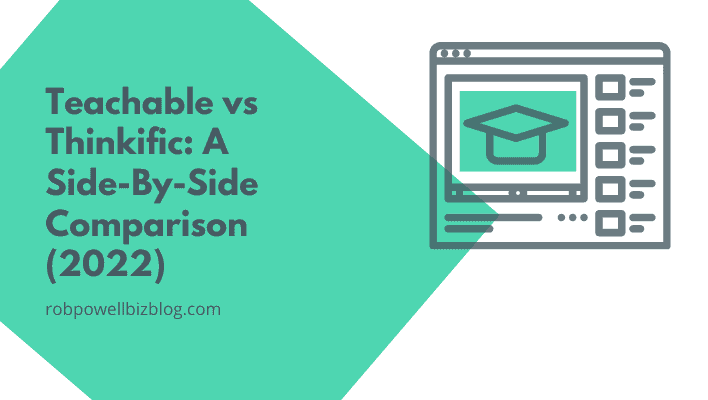
But first of all, what are Teachable and Thinkific?
What are Teachable and Thinkific?
In the world of online learning, there are two basic types of platforms:
- Self-Hosted Online Course Platforms
- Course Market Places
The main difference between the two is control over your learning product.
With a self-hosted online course platform, you control the pricing of your course, the branding of your course, and you keep 100% of the revenue from your course. But you also pay a monthly fee for using the platform.
Examples of self-hosted online course platforms are:
- Teachable
- Thinkific
- Podia
- Kajabi
- Academy of Mine
- Teachery
With a course market place, you have less control over the price of your course, your course carries the branding of the platform, and you only receive a percentage of your course sales. There are no monthly fees on a course market place. Instead, the platform takes a share of your course sales.
Examples of course market places are:
- Udemy
- Udacity
- Skillshare
- Coursera
- LinkedIn Learning (used to be Lynda)
Teachable and Thinkific are the two leaders in self-hosted online course platforms.
Teachable was founded in 2014 and has hosted over 100,000 instructors. In 2020, course creators on Teachable earned close to $400 million and launched 154,500 new courses. Teachable has a staff of over 270.
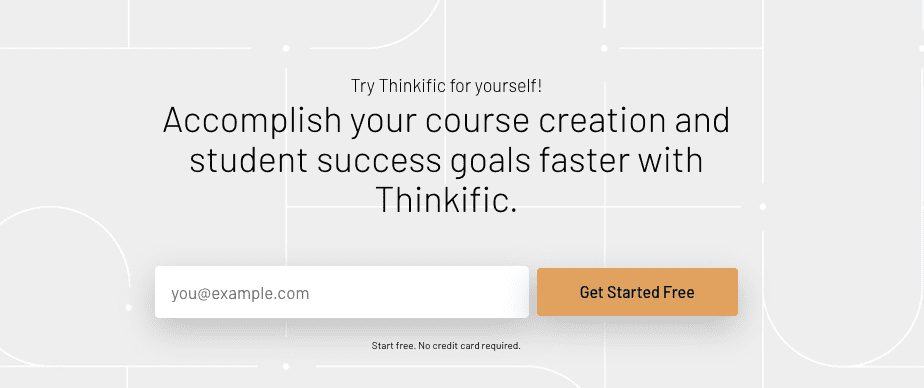
Thinkific was founded in 2012 and currently has over 50,000 active course creators, and over 230 staff.
The reason it’s so difficult to choose between Teachable and Thinkific is that they offer very similar features at fairly similar price points.
But there are differences between them, and that’s what we’ll highlight in this article.
But before getting to that, let’s look at what they have in common: what both platforms offer.
What Do Teachable and Thinkific Both Offer?
Teachable and Thinkific are course creation and course marketing platforms that help you turn your knowledge and expertise into an information product that you can sell.
Both platforms allow you to:
- create and sell courses
- build landing pages
- create subscriptions
- use upsells and order bumps
- drip content
- track student engagement
- set and manage course completion goals
- generate coupon codes
- bundle courses
- conduct email marketing campaigns
- create affiliate marketing programs
And they both offer advanced analytics and reporting.
So where do they differ?
Teachable vs Thinkific: Side-By-Side Comparison
In the remainder of the article, I’ll compare each platform against ten key criteria you should look for when choosing a self-hosted online course platform.
#1. Course Creation
Both platforms allow you to upload a variety of different media into your course lessons. These include video, text, image, audio, and PDF files.
Part of the difference between Teachable and Thinkific comes down to aesthetics. This applies particularly to the course builder in each platform.
This is Thinkific’s course builder:
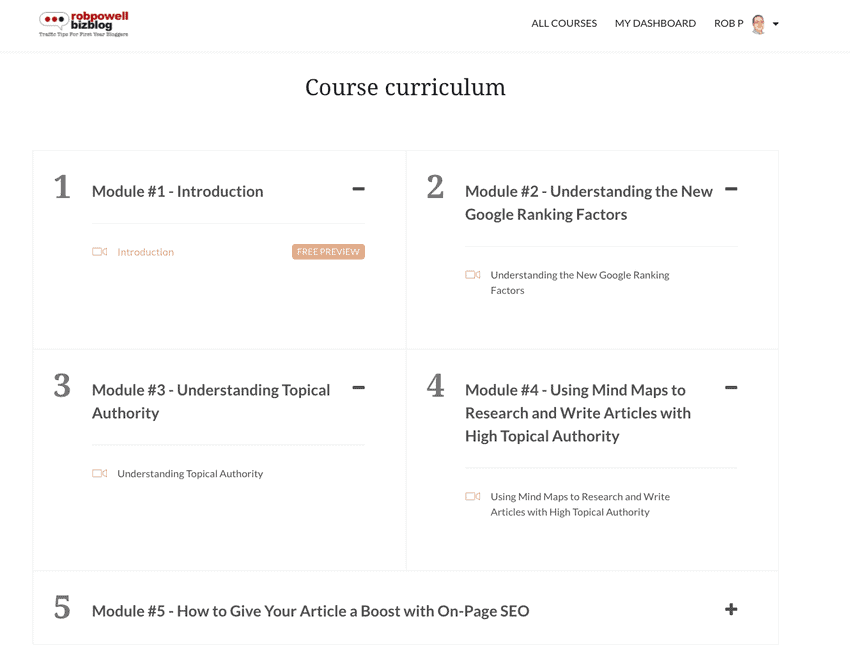
And this is Teachable’s course builder:
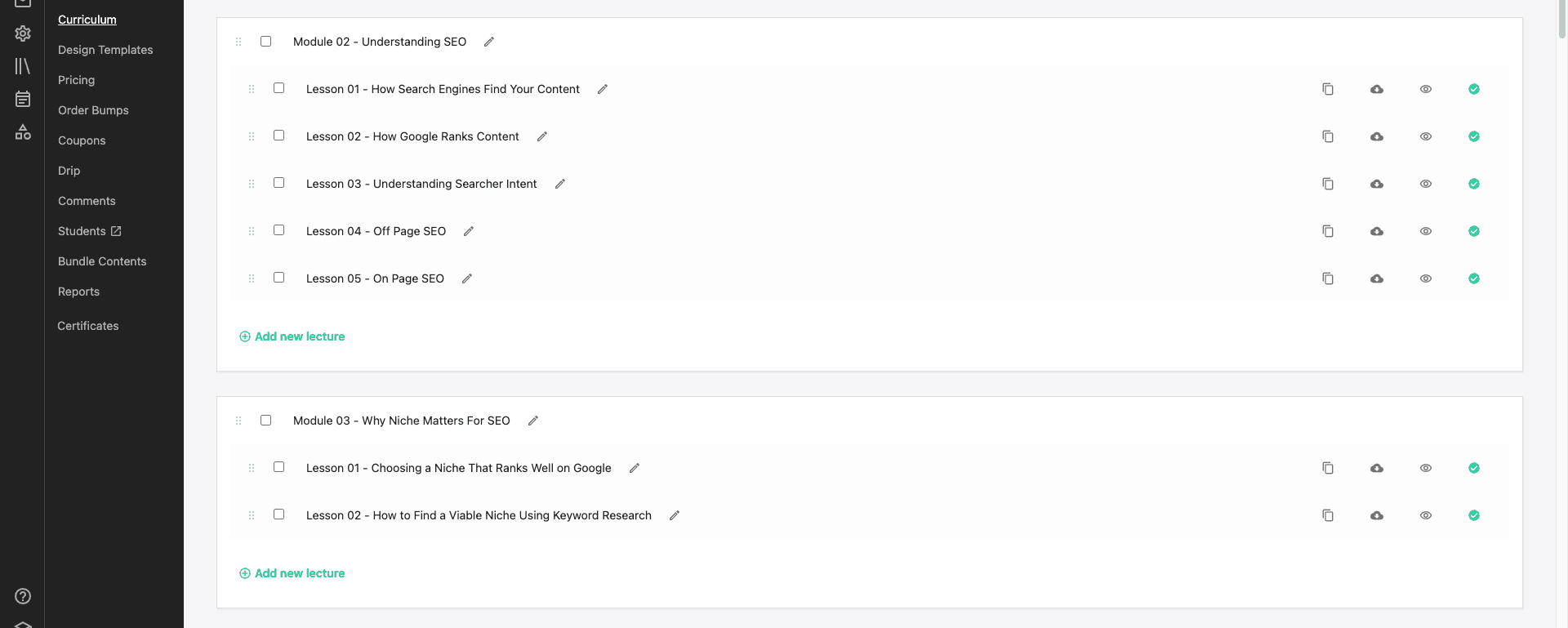
I prefer Teachable’s course builder as it’s more compact and more streamlined. But some people prefer Thinkific’s. In the end, it’s about personal preference.
Both platforms give you unlimited hosting for your videos and other course media.
Teachable allows you to upload your media files directly from cloud services such as DropBox, One Drive, and Google Drive. Thinkific has this feature as well, but you have to upload your videos to the Video Library first. From there, you can then add them to your course.
It’s a small difference but it makes for a better workflow in Teachable.
Another difference is that in Teachable you can perform bulk actions on multiple lessons, using the controls on the right hand side of the interface:

You can’t do this in Thinkific: you have to go into each individual lesson and change the setting there.
One advantage Thinkific has over Teachable is the Video Library. Once a video has been uploaded to the Library, you can use it in different courses. In Teachable, you have to upload it afresh each time.
Winner: Teachable
Teachable’s course builder has a more streamlined user interface and is easier to use. The ability to perform bulk actions across all your lessons makes course creation in Teachable more efficient than in Thinkific.
Both platforms accept the major credit cards plus Stripe and PayPal. However, Teachable has the advantage that it also allows students to pay with Apple Pay®, and Google Pay™.
The checkout process is better in Teachable than in Thinkific.
This is because Thinkific requires the customer to first sign up with Thinkific before going to the checkout page. The problem with this is that you have a potential customer who is primed to order your course. And then suddenly the checkout flow is broken because they first have to fill out a form and sign up to Thinkific. I’m guessing a lot of cart abandonment happens at this point.
Teachable’s checkout flow is much more seamless. You arrive at the checkout page, you enter your email address and your payment details. And boom! Your order goes through.
Winner: Teachable
When you’re selling courses online, checkout flow is important: you don’t want to be losing customers because of unnecessary steps. Teachable’s checkout process is more streamlined than Thinkific’s. So on this count, Teachable wins.
#3. Content Delivery
There are various aspects to course delivery, such as course player, course completion, drip content, and assignments. We’ll go through these different aspects one-by-one.
Course player
The main aspect of content delivery is the course player. And here, I have to say that Teachable’s course player is better designed than Thinkific’s.
Teachable gives the student a better overview of the course content:
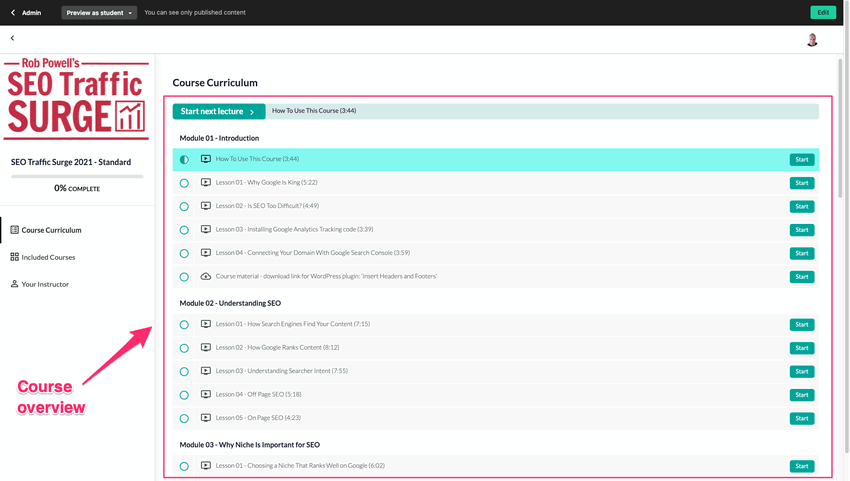
The only course overview the student gets with Thinkific is crammed into the left hand panel:
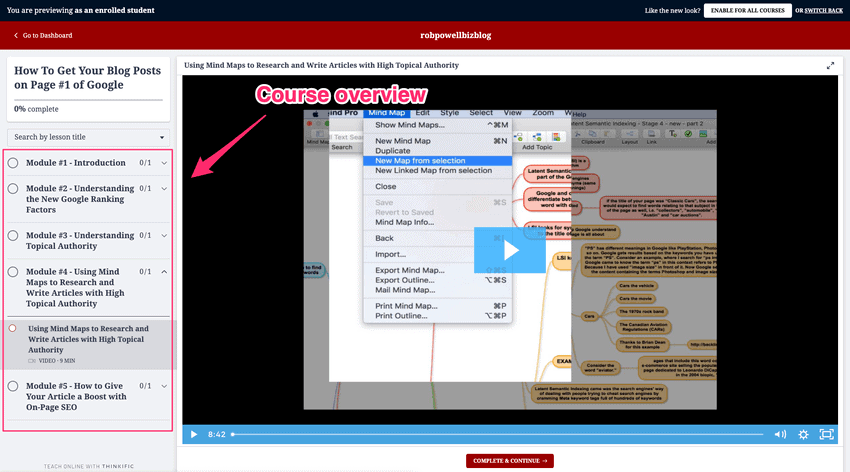
In Teachable, once you click on a lesson, the course player looks quite similar to Thinkific’s:
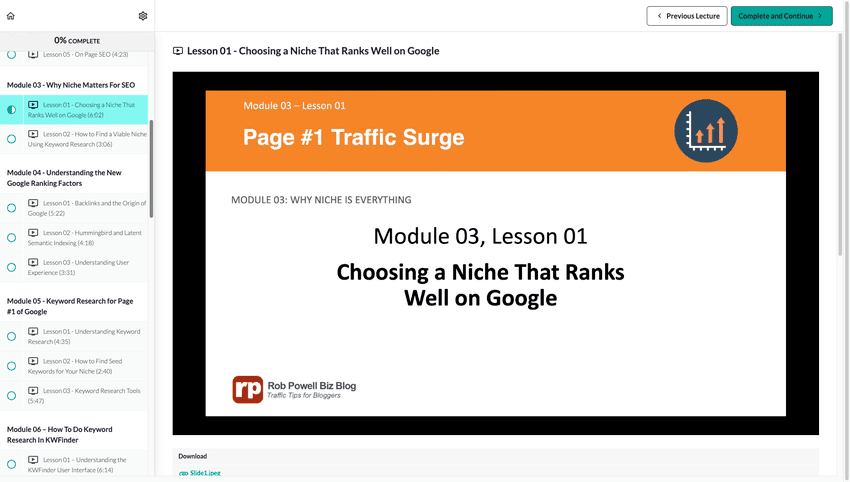
But Teachable gives the student a high-level view of the course content while Thinkific doesn’t.
Course compliance
Both platforms support course compliance. This is where a student must complete a lesson, a video, or a quiz before proceeding to the next lesson.
Teachable refers to this as ‘course compliance’ while Thinkific calls it ‘lesson prerequisites’.
Teachable allows you to set three types of course compliance:
- lecture order (students must progress through the course in a certain order)
- video watching (students must complete 90% of a video before progressing to the next lesson)
- graded quiz completion (students must achieve a certain minimum quiz score before progressing to the next lesson)
The main difference between the two platforms is that Teachable’s course compliance settings are at a course level:
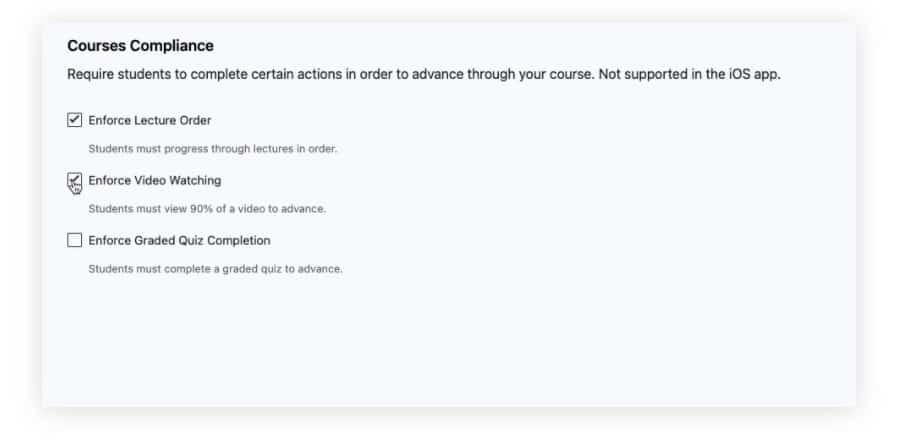
Thinkific’s ‘course prerequisites’ are a bit more advanced than Teachable’s course compliance, because you can set them at the lesson level, not just at the course level.
Also, in Teachable, you just have only one option for percentage of video viewed, which is 90%. But in Thinkific, you can set the percentage yourself.
Drip content
Both platforms allow you to drip your content according to a specific schedule. This is useful if you want your students to only complete one lesson a week to help pace their learning.
In both Teachable and Thinkific you can set the start of the drip by date or by number of days after enrollment.
One advantage of Teachable is that you can set email notifications that go out 15 hours after the drip content is released. This is not available in Thinkific.
Assignments
An advantage of Thinkific is lesson assignments. This is where students submit homework that must be completed and approved before they can complete the course.
Teachable doesn’t have this feature.
Live lessons
Thinkific offers ‘live lessons’. These are scheduled zoom sessions where you can provide coaching or guidance to your students, as a group.
Teachable offers something similar through its ‘coaching’ feature. In Teachable you can use ‘milestones’ to schedule meetings and video calls, though this is on a one-to-one basis rather than in a group.
Winner: Thinkific
In Thinkific you have more control over the course completion settings than in Teachable. Thinkific also allows you to set assignments for individual lessons. This is a feature that Teachable doesn’t offer at all. Also, Thinkific has a built-in integration that lets you offer live lessons to students. Teachable doesn’t have this feature.
In course delivery, Thinkific is the clear winner.
#4. Page Builder
Both Teachable and Thinkific have page builders that you can use to build your course sales page or landing page.
Both platforms have recently improved their page builders. But if you’ve used any of the major drag-and-drop page builders such as Elementor or Thrive Architect, the page builders in Teachable and Thinkific are going to leave you disappointed and frustrated.
Their page builders are clunky to use and offer limited styling options. In Teachable’s page builder, for example, there doesn’t even seem to be an option to change the font family.
Thinkific’s page builder is very similar to Teachable’s. But whereas Teachable just has one theme, Thinkific offers three different themes (Vision, Empire, and Vogue) each with 3-4 styles.
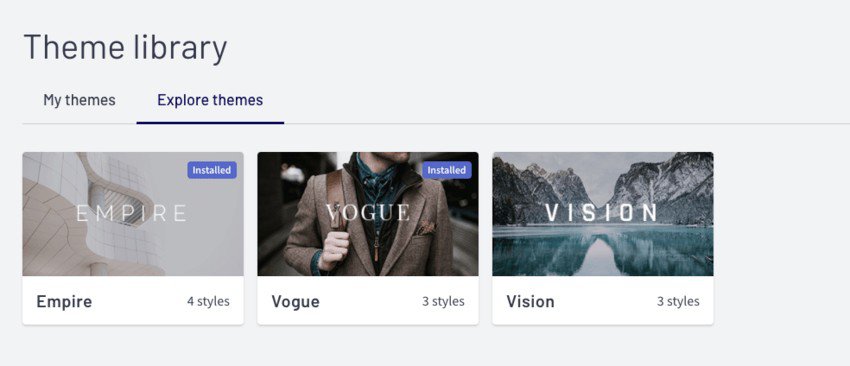
The bottom line with either page builder is this: it’s going to be difficult, if not impossible, for you to replicate the branding and page design you use on your website. Your landing page on either Teachable or Thinkific will be noticeably different in style and layout to the page design you use on your website.
One solution (used by a lot of course creators) is to create your landing pages on your own website, and simply add buttons which link to your course checkout page.
The downside to this workaround is that you won’t be able to use the curriculum widget that both Teachable and Thinkific offer as part of their page builders. That means you’ll have to create your own curriculum display. But you can do that quite easily using a Table of Contents plugin.
Winner: Thinkific
The page builders in both platforms will feel clunky and limited if you are used to using standalone page builders such as Elementor or Thrive Architect. But Thinkific has a slight advantage over Teachable because it offers different themes, each with various different styles. Teachable just has one default theme.
The winner here is Thinkific, by a small margin.
People learn much better when they are actively engaged as opposed to passively receiving information. And that’s why student engagement is a big factor in online learning.
Teachable and Thinkific both offer tools for increasing student engagement, including quizzes, surveys, polls, and discussions.
Quizzes
Both platforms offer graded and non-graded quizzes that you can add to a lesson.
Thinkific offers more options with its quizzes than Teachbale does. For example, a Teachable quiz can only have text answers. But with Thinkific you can insert an image, a video, or an audio file as part of the question or the answer.
You can also import quiz questions into Thinkific, which you can’t do in Teachable.
In Thinkific you can add an explanation field that is displayed regardless of whether a student gets the question right or wrong. As with Teachable, you can set a minimum quiz score as a prerequisite to advancing to the next lesson.
Thinkific has a quiz feature that Teachable doesn’t have: the Randomized Quiz Bank. This is where you upload a series of questions and Thnikific then randomly pulls a number of those questions into a quiz.
Exams
In Thinkific you can even create exams, using a third party platform called Brillium that integrates with Thinkific.
Assignments
As mentioned above, Thinkific allows you to create assignments. Assignments encourage student engagement and improve understanding of course material.
When the assignments come back, you can approve them or reject them and also send feedback to the student.
This is something that Teachbale doesn’t offer.
Surveys and polls
Surveys are a great way to find out more about why a student enrolled in your course and what they are expecting to get from your course. This is vital information as it allows you to constantly re-calibrate your teaching to your students’ needs and expectations.
In Thinkific, surveys are one of ten different types of content you can add to a lesson. For each survey question you can have five different types of answer, including ratings and scales:
By contrast, Teachable doesn’t offer a dedicated survey tool. If you want to create a survey in Teachable, you’ll have to create it in Google Forms and then embed the code in your lesson.
This brings me to an undeniable difference between the two platforms: Thinkific offers far more options in terms of course content than Teachable.
Compare these two screenshots and you’ll see what I mean:
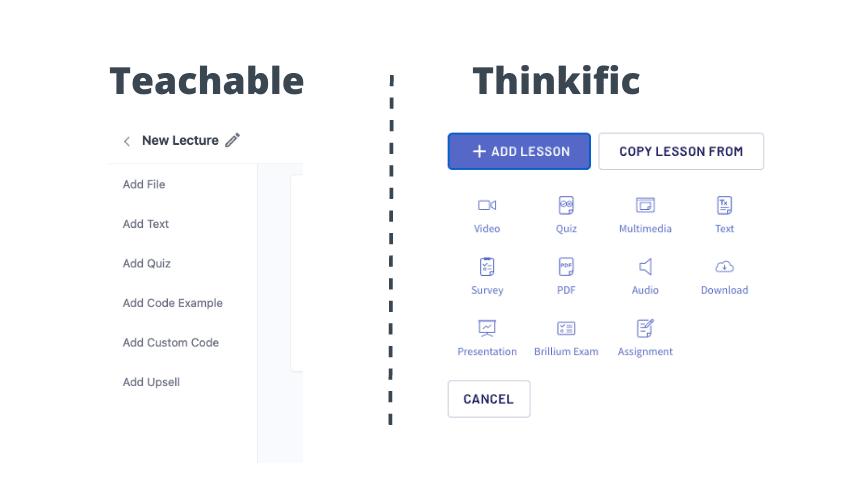
Discussions
Both platforms allow students to comment on course content and discuss it with instructors.
In Teachable, you can enable comments on individual course lectures. Teachable has three settings that affect how comments work:
- Enable Comment Moderation – When this is enabled, any comment that a student makes must be approved by the instructor before it appears in the lesson comments.
- Enable comment attachments – When enabled, this allows students and instructors to upload an image file with their comments.
- Allow multi-level threading of responses – When this is enabled, students can reply to specific comments. This lets students engage in conversation with other students.
Thinkific has a similar commenting system called ‘Discussions’. This is a lesson-level feature where students can comment on a particular lesson. Thinkific also offers course-level commenting through Disqus which you can add to your course.
Winner: Thinkific
Thinkific has more tools than Teachable for keeping your students engaged with your course. Both platforms offer quizzes but Thinkific gives you the option of exams, assignments, and surveys. In student engagement, Thinkific is the clear winner.
#6. Marketing
When you’re selling courses (or anything for that matter), you need all the help you can get. Both platforms offer plenty of marketing tools.
Payment plans
Teachable and Thinkific both give you the option to break your course price into instalments or payment plans. This is a vital marketing tool if your course is priced over $150: many of your potential customers will need to space out their payments over several months.
Coupons
Teachable and Thinkific both allow you to create promotional coupons. These come in handy when you want to do a ‘flash sale’ or create scarcity (create just 15 coupons – first come, first served)
Course bundles
Course bundles are a way of increasing value to your customer. Let’s say you have seven separate courses, each priced at $99; with course bundles you could sell all seven courses as a package for, $500 (for example).
Teachable and Thinkific both allow you to bundle your courses together. This is another key marketing tool that you can use to increase sales.
Upsells
An upsell is where you offer a related product to your customer after they’ve made a purchase.
On Teachable you can insert an upsell into an individual lecture. An good example of an upsell product would be coaching. Go to your curriculum, click into a specific lecture, then click the ‘Add Upsell’ button:
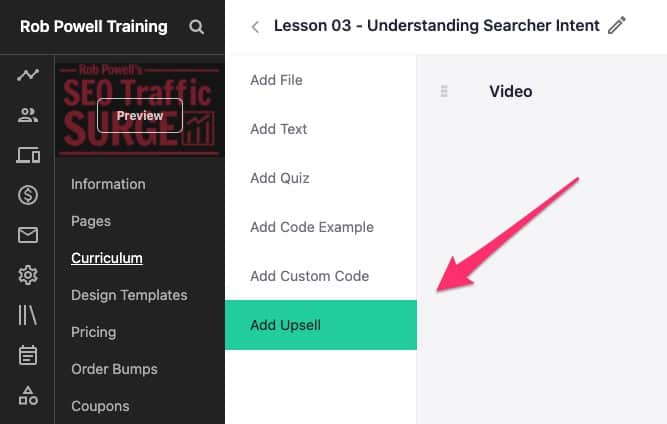
You can also add an upsell by way of the ‘upsell block’ in the page editor. For example, you could add an upsell block to your Thank You page.
Thinkific also offers upsells, which it calls after purchase flows. After purchase flows are added at the course level and can be added to a thank you page or a lesson.
Order bumps
An order bump is where you add an additional product on the checkout page. Order bumps are an important marketing tool; they take advantage of the momentum of the primary sale to offer a related product.
With a single click, your customer can add the additional product to their purchase. This might be another (related) course or coaching.
You can add an order bump to any course or coaching product. Simply go to the checkout page for that product, click the ‘order bump’ button and with a couple more clicks, you’re done.
Like Teachable, Thinkific also offers order bumps. You can add an order bump to the checkout page of any teaching product you have on Thinkific:
![image 19 - thinkific order bump adding an ordr]er bump on Thinkific](https://robpowellbizblog.com/wp-content/uploads/2021/11/image-19-thinkific-order-bump.png)
Winner: Tie
Teachable used to be far ahead of Thinkific in marketing tools. But Thinkific has recently closed the gap. Both platforms now offer payment plans, both offer upsells and order bumps, and both allow you to place a Facebook pixel on your sales page.
On marketing criteria, it’s a draw.
#7. Coaching
In addition to courses, Teachable allows you to create coaching products. This means you can provide one-on-one coaching through video calls and assignments.

Coaching on Teachable consists of ‘milestones’. These milestones are the structure of the coaching and they indicate to clients what they can expect next as they progress through the coaching product.
Thinkific does not, at time of writing, support coaching.
Winner: Teachable
Teachable allows you to offer coaching but Thinkific doesn’t have this feature. So the winner here is Teachable.
#8. Communities
Thinkific offers what they call ‘Thinkific Communities’.
These are groups, rather like a Facebook Group, where your students can gather and interact with you and with each other.
Whereas discussions on Thinkific are lesson specific, Communities are broader in scope. They help keep your students engaged in your course and allow you to build a sense of community around your course.
Teachable also offers a ‘communities’ feature through integration with a third party platform called Circles.so.
However, this is a separate service and requires you to join a paid plan on Circles.so.
Once you have this feature activated, you and your Teachable students are able to access your Circle.so community space seamlessly from within the Teachable dashboard.
Winner: Thinkific
Thinkific has native features for building communities around your courses. You can build communities in Teachable as well, but you have to integrate with (and pay for) a third party app. The winner here is Thinkific.
#9. Customer Support
With Teachable, support is available through a ticket system that operates 7 days a week, 8 AM to 8 PM, with reduced availability at weekends.
However, if you are on Teachable’s Pro Plan, you have access to Live Chat.
Thinkific also uses a ticketing system. But unlike Teachable, you’ll first have to look at a bunch of articles before you can send your email request.
If you’re on Thinkific’s Basic Plan, you’ll have access to Live Chat.
To give you an idea of each platform’s turnaround time on email support, I sent a request to both Thinkific and Teachable. In both cases, I logged in a free user
I sent an email request to Thinkific on a Thursday and I got a reply on the following Sunday. Not great but not too bad either.
I sent an email request to Teachable on a Sunday and I had a reply, with an answer to my question, on the Monday.
Winner: Tie
Thinkific gives you Live Chat on the Basic plan whereas with Teachable you have to be on the Pro plan to get Live Chat. But at the level of the Free plan, Teachable lets you open a ticket without having to view a bunch of articles, and their response time was quicker.
So on the issue of support, it’s a tie.
#10. Pricing
Teachable and Thinkific’s pricing is very similar. The main difference is that Teachable makes their Basic plan more affordable than Thinkific’s, while Thinkific makes their Pro plan more affordable than Teachable’s
Teachable has four tiers in its pricing:
- Free: $0 p/month
- Basic: $29 p/month (billed annually)
- Pro: $99 p/month (billed annually)
- Business: $249 p/month (billed annually)
Thinkific also has four pricing tiers:
- Free: $0 p/month
- Basic: $39 p/month (billed annually)
- Pro: $79 p/month (billed annually)
- Premier: $399 p/month (billed annually)
Let’s compare these four plans side-by-side.
Free plan
- Thinkific’s free plan gives you the core features plus three courses. By contrast, Teachable’s free plan gives you the core features plus unlimited courses.
- On the free plan, Teachable charges $1 + 10% per transaction (i.e. per course sale), whereas with Thinkific’s free plan, there are no charges per sale.
- Thinkific gives you graded quizzes in the free plan, whereas on Teachable you have to be on the Pro plan to get graded quizzes
Winner: Thinkific
Thinkific’s free plan has two advantages over Teachable’s free plan: no charges per transaction plus graded quizzes. The only advantage in Teachable’s free plan is unlimited courses.
But if you are using the free plan to get established as a course creator, I’m guessing you’re going to want to upgrade to at least the Basic plan after one or two courses. So I’m not sure that unlimited courses in Teachable’s free plan is a huge drawcard.
Basic plan
- Teachable’s Basic plan is slightly more affordable than Thinkific’s ($29 p/month vs $39 p/month). But on the Basic plan, Teachable charges 5% per transaction, whereas Thinkific has no charges per transaction.
- With Thinkific’s Basic plan you get Live Chat support, but with Teachable this is only available on the Pro plan and above.
Winner: Thinkific
At first glance, Teachable’s Basic plan is more attractive than Thinkific’s basic plan because its $10 p/month cheaper. But Teachable will be charging you 5% per transaction on the Basic plan. Depending on how many courses you sell per month, Teachable’s $10 p/month advantage could easily disappear in transaction fees.
The Live Chat support you get with Thinkific’s Basic plan will be a big factor for some people (on Teachable you need the Pro plan to get Live Chat).
Pro plan
- Thinkific’s Pro plan is more affordable than Teachable’s ($79 p/month vs $99 p/month).
- Teachable’s Pro plan gives you 5 admin-level users, whereas Thinkific’s Pro plan gives you 2 admin-level users
- Thinkific’s Pro plan supports live lessons (with Zoom), whereas Teachable doesn’t have native support for live lessons (on any plan).
Winner: Thinkific
Thinkific’s Pro plan is $20 p/month cheaper than Teachable’s. Teachable gives you three extra admin-level users, but I doubt that’s going to be a big issue for solopreneurs and SMBs.
Given the extra student engagement tools and content delivery features you get with Thinkific, the winner here is Thinkific. Even if the two Pro plans were both $99 p/month, I’m guessing that many people would view Thinkific’s plan as more attractive.
Conclusion
Teachable and Thinkific are both excellent online course platforms. Thinkific has better course completion settings and student engagement tools than Teachable.
Teachable used to be better than Thinkific for marketing, but now they both offer the same set of marketing tools such as upsells, order bumps, and payment plans.
The course builder and course player is better designed in Teachable, in my opinion. But otherwise, Thinkific probably has the edge on Teachable, especially when you consider that Thinkific’s Pro plan is $20 p/month less than Teachable’s